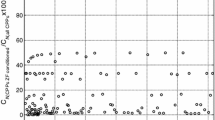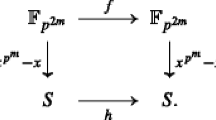Abstract
Permutation polynomials (PPs) are used for interleavers in turbo codes, cryptography or sequence generation. The paper presents an algorithm for determining the number of true different PPs of degrees up to five. It is based on the algorithm from Weng and Dong (IEEE Trans Inf Theory 54(9):4388–4390, 2008) and on the null polynomials modulo the interleaver length.
Similar content being viewed by others
Explore related subjects
Discover the latest articles, news and stories from top researchers in related subjects.References
Takeshita, O. Y. (2007). Permutation polynomial interleavers: An algebraic-geometric perspective. IEEE Transactions on Information Theory, 53(6), 2116–2132.
Sun, J., & Takeshita, O. Y. (2005). Interleavers for turbo codes using permutation polynomials over integer rings. IEEE Transactions on Information Theory, 51(1), 101–119.
Takeshita, O. Y. (2006). On maximum contention-free interleavers and permutation polynomials over integer rings. IEEE Transactions on Information Theory, 52(3), 1249–1253.
Ryu, J., & Takeshita, O. Y. (2006). On quadratic inverses for quadratic permutation polynomials over integer rings. IEEE Transactions on Information Theory, 52(3), 1254–1260.
Takeshita, O.Y. (2006). A new metric for permutation polynomial interleavers. In Proceedings of IEEE international symposium on information theory (ISIT), Seattle, USA, pp. 1983–1987.
Rosnes, E., & Takeshita, O.Y. (2006). Optimum distance quadratic permutation polynomial-based interleavers for turbo codes. In Proceedings of IEEE international symposium on information theory (ISIT), Seattle, USA, pp. 1988–1992.
Tarniceriu, D., Trifina, L., & Munteanu, V. (2009). About minimum distance for QPP interleavers. Annals of Telecommunications, 64(9–10), 745–751.
Zhao, H., Fan, P., & Tarokh, V. (2010). On the equivalence of interleavers for turbo codes using quadratic permutation polynomials over integer rings. IEEE Communications Letters, 14(3), 236–238.
Trifina, L., Tarniceriu, D., & Munteanu, V. (2011). Improved QPP interleavers for LTE standard. In Proceedings of IEEE international symposium on signals, circuits and systems (ISSCS), Iasi, Romania, pp. 403–406.
Ryu, J. (2012). Efficient address generation for permutation polynomial based interleavers over integer rings. IEICE Transactions on Fundamentals of Electronics, Communications and Computer Sciences, E95–A(1), 421–424.
Lahtonen, J., Ryu, J., & Suvitie, E. (2012). On the degree of the inverse of quadratic permutation polynomial interleavers. IEEE Transactions on Information Theory, 58(6), 3925–3932.
Rosnes, E. (2012). On the minimum distance of turbo codes with quadratic permutation polynomial interleavers. IEEE Transactions on Information Theory, 58(7), 4781–4795.
Trifina, L., Tarniceriu, D., & Munteanu, V. (2012). On dispersion and nonlinearity degree of QPP interleavers. Applied Mathemathics & Information Sciences, 6(3), 397–400.
Ryu, J. (2012). Permutation polynomials of higher degrees for turbo code interleavers. IEICE Transactions on Communications, E95–B(12), 3760–3762.
Trifina, L., & Tarniceriu, D. (2014). Improved method for searching interleavers from a certain set using Garello’s method with applications for the LTE standard. Annals of Telecommunications, 69(5–6), 251–272.
3GPP TS 36.212 V8.3.0, 3rd Generation Partnership Project, Multiplexing and channel coding (Release 8), 2008. http://www.etsi.org/deliver/etsi_ts/136200136299/136212/08.03.0060/ts136212v080300p.pdf. Accessed June 5, 2015.
Trifina, L., & Tarniceriu, D. (2013). Analysis of cubic permutation polynomials for turbo codes. Wireless Personal Communications, 69(1), 1–22.
Chen, Y.-L., Ryu, J., & Takeshita, O. Y. (2006). A simple coefficient test for cubic permutation polynomials over integer rings. IEEE Communications Letters, 10(7), 549–551.
Zhao, H., & Fan, P. (2007). A note on A simple coefficient test for cubic permutation polynomials over integer rings. IEEE Communications Letters, 11(12), 991.
Weng, G., & Dong, C. (2008). A note on permutation polynomials over \(\mathbb{Z}_n\). IEEE Transactions on Information Theory, 54(9), 4388–4390.
Ryu, J. (2007). Permutation polynomial based interleavers for turbo codes over integer rings. Ph.D. Thesis. https://etd.ohiolink.edu/rws_etd/document/get/osu1181139404/inline. Accessed February 1, 2011.
Ryu, J., & Takeshita, O.Y. (2011). On inverses for quadratic permutation polynomials over integer rings. arxiv:1102.2223v1. Accessed March 18, 2011.
Trifina, L., & Tarniceriu, D. (2017). A simple method to determine the number of true different quadratic and cubic permutation polynomial based interleavers for turbo codes. Telecommunication Systems, 64(1), 147–171.
Nöbauer, W. (1965). Über permutationspolynome und permutationsfunktionen für primzahlpotenzen. Monatshefte für Mathematik, 69(3), 230–238.
Mullen, G. L., & Stevens, H. (1984). Polynomial functions \((\text{ mod } m)\). Acta Mathematica Hungarica, 44(3–4), 237–241.
Hardy, G. H., & Wright, E. M. (1975). An Introduction to the Theory of Numbers (4th ed.). Oxford: Oxford University Press.
Dickson, L. E. (1896–1897). The analytic representation of substitutions on a power of a prime number of letters with a discussion of the linear group. Annals of Mathematics, 11(1/6), 65–120.
Rivest, R. L. (2001). Permutation polynomials modulo \(2^w\). Finite Fields and Their Applications, 7(2), 287–292.
Trifina, L., & Tarniceriu, D. (2017). A coefficient test for quintic permutation polynomials. Submitted to publication.
Trifina, L., & Tarniceriu, D. (2016). The number of different true permutation polynomial based interleavers under Zhao and Fan sufficient conditions. Telecommunication Systems, 63(4), 593–623.
Zhao, H., & Fan, P. (2007). Simple method for generating \(m\)th-order permutation polynomials over integer rings. Electronics Letters, 43(8), 449–451.
Author information
Authors and Affiliations
Corresponding author
Rights and permissions
About this article
Cite this article
Trifina, L., Tarniceriu, D. Determining the number of true different permutation polynomials of degrees up to five by Weng and Dong algorithm. Telecommun Syst 67, 211–215 (2018). https://doi.org/10.1007/s11235-017-0335-y
Published:
Issue Date:
DOI: https://doi.org/10.1007/s11235-017-0335-y




